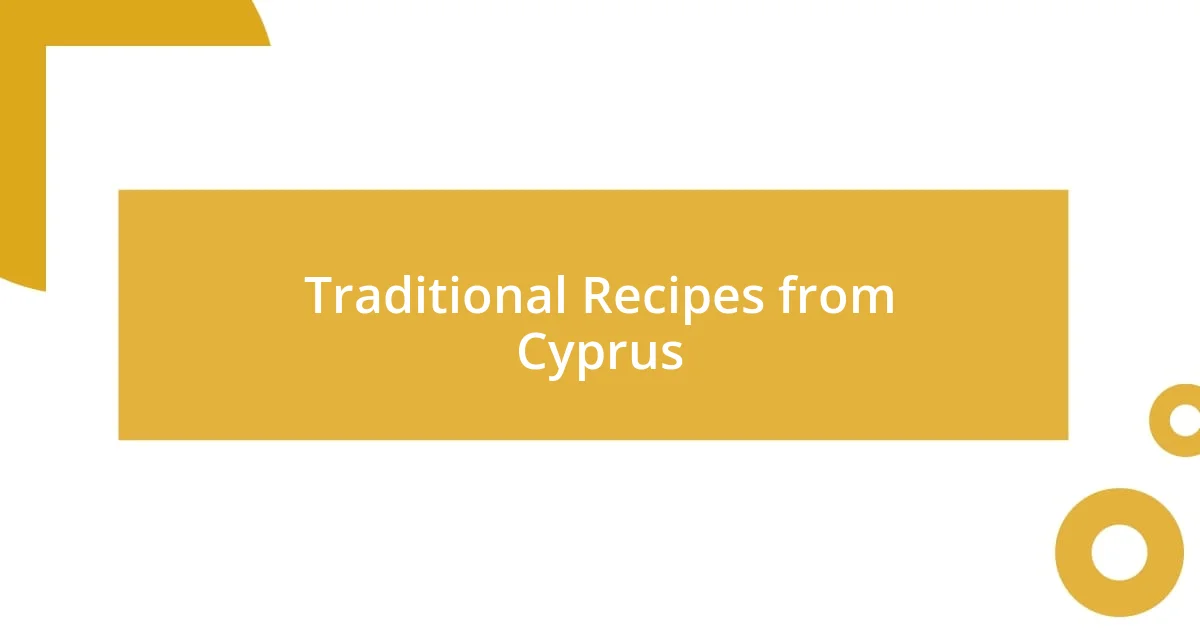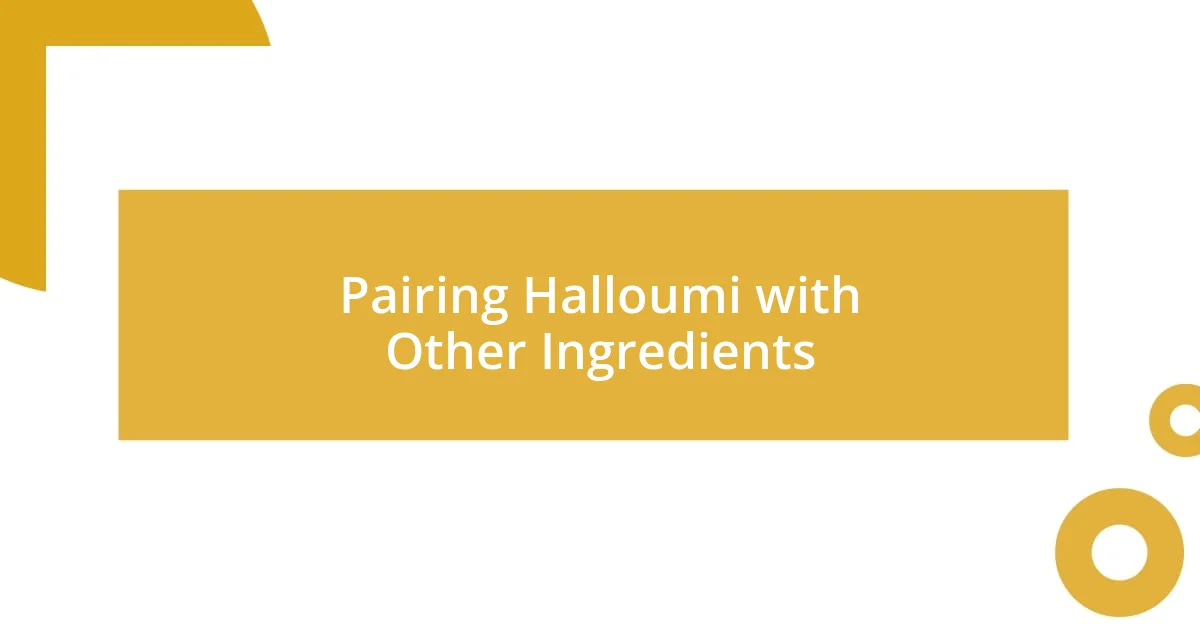Key takeaways:
- Halloumi’s unique texture and high melting point make it ideal for grilling, creating a variety of delicious and versatile dishes in Cypriot cuisine.
- Choosing quality halloumi involves looking for firm texture, brine packaging, and a balanced taste profile to enhance culinary experiences.
- Halloumi pairs well with fresh herbs, tomatoes, and fruits, allowing for creative modern dishes while maintaining the essence of traditional Cypriot flavors.

Understanding Cypriot Halloumi Dishes
When I first encountered halloumi, I was struck by its unique texture and flavor. This semi-hard cheese made from a mix of goat’s and sheep’s milk is not just a staple in Cypriot cuisine; it embodies the essence of Mediterranean dining. Can you imagine a warm summer evening, the sun dipping below the horizon, while savoring grilled halloumi drizzled with olive oil? It’s a taste that lingers.
Halloumi is renowned for its high melting point, which makes it perfect for grilling or frying. I remember the first time I tried it sizzling on the grill at a friend’s family gathering in Cyprus. The crispy exterior contrasted wonderfully with its soft, creamy center. Each bite was a revelation, sparking a deeper appreciation for the diverse ways halloumi can be prepared and served.
What really captivates me about Cypriot halloumi dishes is their versatility. You can enjoy it in a salad, paired with fresh vegetables and herbs, or as part of a traditional mezze spread. Each preparation tells a story rooted in tradition and local ingredients, inviting us to explore the rich culinary culture of Cyprus. I often find myself experimenting with different combinations, each time discovering a new favorite way to enjoy this delightful cheese.

Choosing Quality Halloumi Cheese
Choosing the right halloumi cheese can truly elevate your dish from good to unforgettable. I always look for halloumi that has a firm texture with a slight springiness when pressed; this indicates freshness. During a visit to a local farmers’ market, I discovered a vendor who sourced theirs from a small Cypriot farm, the rich aroma intoxicating as I sampled different varieties.
I’ve learned to pay attention to the packaging as well. Authentic halloumi often comes in a brine solution, which not only preserves its flavor but also enhances its salty tang. I’ll never forget the first time I noticed the distinct packaging of a high-quality halloumi. The difference was palpable; it was as though I had been missing out on the true potential of this cheese until then.
The taste profile is also a critical aspect when choosing halloumi. I prefer the ones that have a balanced saltiness and a hint of tang from the goat’s milk. This combination brings depth to any dish. Just last summer, I grilled some halloumi from that farmer’s market. The first bite was a savory dance between the sweet grilled peppers and the tangy cheese, a reminder of how significant quality is in achieving that perfect bite.
| Quality Indicators | Description |
|---|---|
| Firm Texture | Look for halloumi that is firm yet springy to the touch. |
| Brine Packaging | Authentic halloumi should be stored in brine for flavor preservation. |
| Taste Profile | Choose varieties with balanced saltiness and a hint of tang from goat’s milk. |

Traditional Recipes from Cyprus

Traditional Recipes from Cyprus
Cypriot cuisine is a beautiful tapestry of flavors, with halloumi at the heart of many traditional recipes. I fondly recall my first experience making Halloumi Saganaki, a dish of fried halloumi that became a family favorite. The crispy, golden cheese paired with a squeeze of fresh lemon created a melty explosion of flavor that has lingered in my memory. It’s simple yet so gratifying, a perfect example of how Cypriots embrace the ingredients right from their lands.
Some traditional Cypriot halloumi dishes include:
– Grilled Halloumi with Honey: A delicious contrast between the savory cheese and sweet drizzle of honey.
– Halloumi and Vegetable Skewers: Colorful peppers, zucchini, and onions, beautifully grilled alongside cubes of halloumi, make for a treat at any gathering.
– Halloumi Stuffed Peppers: Ripe peppers filled with a mix of halloumi, herbs, and rice, cooked to perfection in the oven.
Each of these recipes reflects the warmth of Cypriot hospitality, a celebration of simple ingredients that are taken to new heights through love and care. I believe trying these dishes brings a little piece of Cyprus into my home and creates moments that are truly memorable.

Modern Twists on Halloumi
Exploring modern twists on halloumi has truly opened up a world of culinary creativity for me. One memorable evening, I experimented with halloumi tacos, using warm corn tortillas and a fresh mango salsa; the salty cheese paired perfectly with the sweetness of the fruit. It made me wonder, have you ever thought about cheese in a taco? The result was a delightful fusion that surprised my taste buds and left my friends wanting more.
I’ve also discovered the joy of halloumi in salads—especially when roasted. Just toss some slices with olive oil, a sprinkle of chili flakes, and let them caramelize in the oven. I remember serving this at a summer get-together; everyone was raving about the crispy texture contrasted with the fresh greens. It’s incredible how something so simple can elevate a salad from mundane to extraordinary. Have you ever thought about how using halloumi can add depth to your favorite dishes?
Another fun modern take is incorporating halloumi into breakfast dishes. Picture this: a sunny-side-up egg resting on a bed of sautéed spinach, topped with grilled halloumi slices. The creamy cheese mixed with the egg yolk was a game-changer—every bite tasted like a weekend treat. It made me realize how versatile halloumi truly is, fitting seamlessly into different meal times while providing a unique twist that keeps things exciting in the kitchen.

Pairing Halloumi with Other Ingredients
When it comes to pairing halloumi, I’ve found that fresh herbs can elevate the cheese in unexpected ways. I often sprinkle chopped mint and parsley over grilled halloumi, and the bursts of flavor transport me back to sunny afternoons in Cyprus. Have you ever tried this simple combination? The herbs harmonize beautifully, creating a refreshing bite that’s perfect for hot weather.
I can’t help but rave about the magical synergy between halloumi and tomatoes. One of my favorite dishes involves layering slices of halloumi with ripe, juicy tomatoes and a drizzle of balsamic reduction. The saltiness of the cheese balances the acidity of the tomatoes, creating a dish that feels indulgent yet light. It brings me joy to serve this at gatherings—it never fails to impress my friends!
Moreover, halloumi paired with fruits like figs or watermelon is a combination I can’t resist. I once prepared a summer salad featuring grilled halloumi, sweet figs, and a handful of arugula tossed in a light vinaigrette. The contrasting textures and flavors had everyone at the table smiling, and they all exclaimed how delightful the mix was. It made me realize how halloumi truly shines when it meets sweet elements, creating a unique harmony that is simply unforgettable.

Tips for Cooking Halloumi
Cooking halloumi can be a rewarding experience, but a few tips can enhance that journey. First, don’t be afraid to experiment with oil! I typically use a high-quality olive oil when grilling or frying halloumi, as the rich flavor accents the cheese beautifully. Just last week, I decided to infuse my oil with garlic before cooking, and the aroma transported me back to a quaint Cypriot kitchen. Have you tried infusing oils yet?
Another tip that I’ve come to love is ensuring the grill or pan is hot enough before adding the halloumi. If it sizzles when it hits the surface, you’re on the right track. I once didn’t preheat my skillet properly, and instead of that golden crust, I ended up with a boring, soft texture. It was a lesson learned! The perfect heat creates that delightful crust that really elevates the dish.
Lastly, I recommend slicing halloumi thicker than you might think. I’ve found that thicker slices hold up better during cooking and create that wonderfully chewy bite. One time, I cut them a bit slim and they disappeared into mere shreds on the grill. Have you ever been disappointed because of a simple miscalculation? Larger pieces allow for a satisfying experience and ensure they won’t just melt away.

Serving Halloumi for Special Occasions
When celebrating special occasions, I often serve halloumi as an elegant centerpiece on my table. One memorable gathering featured a halloumi platter adorned with vibrant roasted vegetables, olives, and a sprinkle of pomegranate seeds. It was a visual feast that not only delighted my guests but also sparked conversations about food memories and culinary journeys—not to mention how such a simple ingredient could create such excitement!
I vividly recall hosting a dinner party where I paired halloumi with saffron-infused rice. The aroma wafted through the air, creating an inviting atmosphere that made everyone eager to dig in. Serving it warm allowed the cheese to maintain its unique texture while complementing the exotic flavors of saffron perfectly. Have you ever noticed how a single dish can elevate the mood of an entire gathering? That night, we shared laughter and stories, united by our love for good food.
On festive occasions, I love to grill halloumi skewers, infused with a marinade of lemon and herbs—simple yet utterly delicious. One time, as we gathered around the barbecue, the skewers sizzled and filled the air with a tantalizing scent. Watching my friends eagerly reach for the next skewer brought back memories of family barbecues in Cyprus, making the experience even more meaningful. It’s moments like these that remind me of the joy in sharing food, and halloumi brings that joy to every special occasion.















